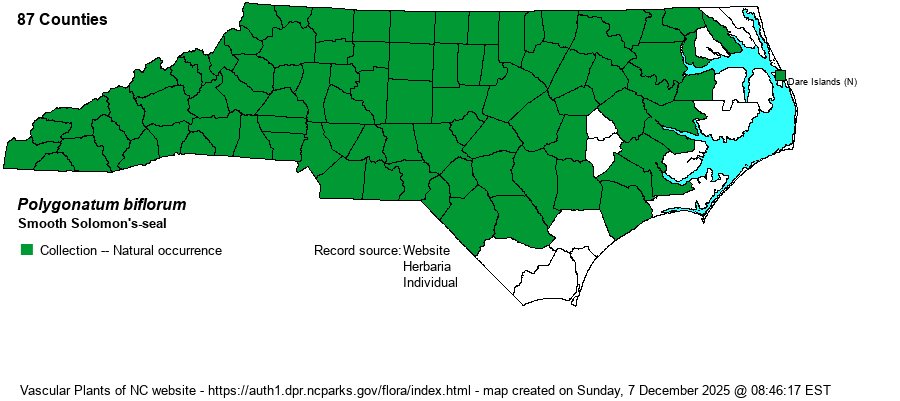| Author | (Walter) Elliott | |
| Distribution | Throughout the Mountains, Piedmont, and most of the Coastal Plain, but only sparsely reported from coastal counties.
This is a wide-ranging species, from the eastern two-thirds of Canada south to central FL and AZ. | |
| Abundance | Common in the Mountains, Piedmont, and the western and central Coastal Plain, uncommon in the Sandhills proper. Scarce within about 50 miles of the coast, though there are a few such records. | |
| Habitat | As with False Solomon's-seal (Maianthemum racemosum), this species has a wide range of mesic to moist forested habitats. It favors Mesic Mixed Hardwood Forests, but it occurs in cove forests, bottomland forests, and fairly dry hardwood and mixed forest slopes, as well. Both of these species often grow together on the same forested slope. | |
| Phenology | Blooms from April into June, and fruits from August to October. | |
| Identification | As with the other lily mentioned in Habitat, both of these species should be familiar to nearly all outdoor enthusiasts. The description is needed because of the quite similar Hairy Solomon's-seal (P. pubescens), which is widespread in the mountains and can be tricky for some people to identify. Smooth Solomon's-seal has a gracefully arching stem that can grow to 3-5 feet long in the mountains (var. commutatum), though more often about 2 feet long downstate. As with False Solomon's-seal, there are numerous alternate elliptical and entire leaves along the stem, also two-ranked (into a single plane). The leaves average about 4 inches long and also are strongly parallel-veined, but the stem is not zigzag and it is generally a pale green or almost whitish in color, helping to separate it from False Solomon's-seal when not in bloom. When in bloom, it has one to several small, pale green to white, narrow flowers that dangle downward from each leaf axil; each flower is about 2/3-inch long. When in bloom, this species is not a striking wildflower, but its gracefully arching stem with dangling tubular flowers is quite noticeable. The similar P. pubescens, not uncommon in the mountains, averages quite a bit smaller, mostly to about 2 inches long/tall, with somewhat smaller leaves that are quite pubescent on the veins on the leaf undersides. Thus, to separate the two Solomon's-seals, rub your fingers along the leaf undersides, or look closely at them, as P. biflorum is smooth on the leaf undersides. | |
| Taxonomic Comments | Weakley (2018) and NatureServe list two varieties found in the state; P. biflorum var. commutatum is limited to the mountains and apparently the upper Piedmont, whereas the smaller P. biflorum var. biflorum is found statewide.
| |
| Other Common Name(s) | Great Solomon's-seal | |
| State Rank | S5 | |
| Global Rank | G5 | |
| State Status | | |
| US Status | | |
| USACE-agcp | FACU link |
| USACE-emp | FACU link |

